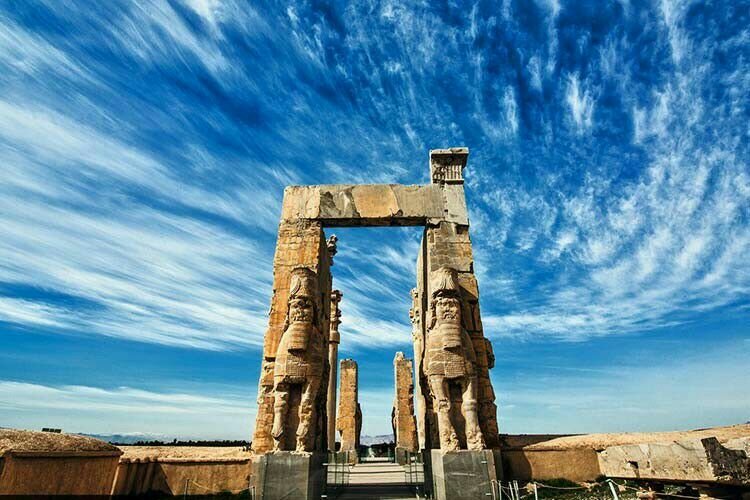New light shed on Persepolis

TEHRAN – An archaeological discovery lately been made in the vicinity of Persepolis has shed new light on the once ceremonial capital of the Achaemenid empire.
Excavations and surveys on Tall-e-Ajori, which is situated in the surrounding areas of the UNESCO-registered Persepolis, are expected to help archaeologists uncover more about the history of the royal city.
Regarding the significance of such excavations around Persepolis, the director of the World Heritage site on Wednesday noted: “[Some] half of the ancient world was led and managed from the Persepolis.”
There is ample evidence for the claim, which could be found across the Marvdasht plain, which is also home to the UNESCO-registered Pasargadae, and several historical sites as well as villages and small towns scattered in an area of 85,000 hectares around Persepolis, Hamid Fadaei added.
However, protecting and preserving such a vast area would be a challenging and time-consuming task, he explained.
The official also noted that besides the archeological significance, the ecosystem and natural resources, and capacities of the area should be taken into consideration.
Supervised by a joint mission of Iranian and Italian archaeologists and cultural heritage experts, the excavations on Tall-e-Ajori uncovered vestiges of a massive gateway measuring 30 by 40 meters with a height of approximately 12 meters.
The archaeologists succeeded in proving that Cyrus had ordered the construction of the gateway near Persepolis in Tall-e-Ajori and that this magnificent gateway had been put into operation during the reign of his son Cambyses.
“The building had a corridor in the center, which was in form of a rectangular room measuring eight by twelve meters, and inside this central room, there were four living chairs. And the central corridor opened on both sides to the Achaemenid campus,” according to Alireza Askari-Charoudi who is a senior Iranian archaeologist.
The royal city of Persepolis ranks among the archaeological sites which have no equivalent, considering its unique architecture, urban planning, construction technology, and art.
Persepolis, also known as Takht-e Jamshid, whose magnificent ruins rest at the foot of Kuh-e Rahmat (Mountain of Mercy) is situated 60 kilometers northeast of the city of Shiraz in Fars province.
The city was burnt by Alexander the Great in 330 BC apparently as revenge to the Persians because it seems the Persian King Xerxes had burnt the Greek City of Athens around 150 years earlier.
The city’s immense terrace was begun about 518 BC by Darius the Great, the Achaemenid Empire’s king. On this terrace, successive kings erected a series of architecturally stunning palatial buildings, among them the massive Apadana palace and the Throne Hall (“Hundred-Column Hall”).
This 13-ha ensemble of majestic approaches, monumental stairways, throne rooms (Apadana), reception rooms, and dependencies is classified among the world’s greatest archaeological sites.
Persepolis was the seat of the government of the Achaemenid Empire, though it was designed primarily to be a showplace and spectacular center for the receptions and festivals of the kings and their empire.
The site is marked by a large terrace with its east side abutting the Kuh-e Rahmat (“Mount of Mercy”). The other three sides are formed by a retaining wall, varying in height with the slope of the ground from 13 to 41 feet (4 to 12 meters); on the west side, a magnificent double stair in two flights of 111 short stone steps leads to the top. On the terrace are the ruins of several colossal buildings, all constructed of a dark gray stone (often polished to a marble-like surface) from the adjacent mountain.
According to Britannica, the stone was cut with the utmost precision into blocks of great size, which were laid without mortar; many of them are still in place. Especially striking are the huge columns, 13 of which still stand in the audience hall of Darius I (the Great; reigned 522–486 BC), known as the Apadana, the name given to a similar hall built by Darius at Susa. There are two more columns still standing in the entrance hall of the Gate of Xerxes, and a third has been assembled there from its broken pieces.
In 1933 two sets of gold and silver plates recording in the three forms of cuneiform—ancient Persian, Elamite, and Babylonian—the boundaries of the Persian empire were discovered in the foundations of Darius’s hall of audience. Several inscriptions, cut in stone, of Darius I, Xerxes I, and Artaxerxes III indicate to which monarch the various buildings were attributed.
ABU/AFM
Leave a Comment